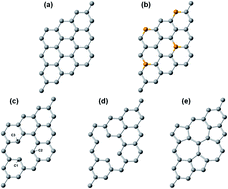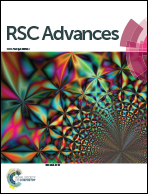DFT study of Rh-decorated pristine, B-doped and vacancy defected graphene for hydrogen adsorption
Abstract
Rh adatom stability on graphene, with and without defects has been investigated by density functional theory (DFT) calculations to evaluate the feasibility to achieve a uniform dispersion of the metallic atom. Different defects introduced include B dopants, single vacancies and double 585 and 555-777 type vacancies. An energetic analysis of the hydrogen adsorption capacity for the different Rh decorated graphene structures was also performed. Dispersion force contribution to the adsorption energy was determined in order to obtain a quantitative method to know whether H2 molecules adsorbed chemically or the adsorption on the Rh decorated graphene supports is controlled by van der Waals forces. Partial density of states (PDOS) for the different systems, were obtained to understand the Rh–C, H2–Rh (adsorbed) and H–H interactions and magnetic effects, before and after Rh and H2 adsorption. When H2 molecules bind to Rh adatoms, an electrostatic interaction occurs due to a charge transfer from the metal to the graphene surfaces after adsorption. Bonding and Bader charge analysis are also included.


 Please wait while we load your content...
Please wait while we load your content...